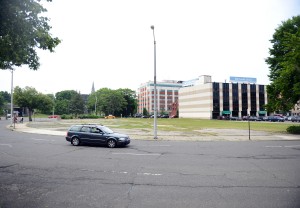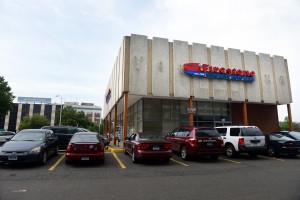BY HUGH BAILEY
Hearst Connecticut Media
The grid, the basic unit of city life, was all but banished. For a generation of city planners, progress meant pushing suburban features deep into the heart of cities, with development based around cars and all their voracious needs.
Wide boulevards and vast parking lots replaced traditional streetscapes. Highways bulldozed through neighborhoods, and malls took the place of walkable streets.
But the trends have shifted. Across the country, people are driving less than in past generations, and in response cities are tearing down expressways, building on parking lots and emphasizing pedestrian-friendly amenities. In Bridgeport, which was largely bypassed by post-war urban renewal, this means the continued rethinking of the Lafayette Boulevard corridor and the end of Lafayette Circle as it exists today, with the street grid to return at the city”™s front door.

- Plans are in place to turn Lafayette Circle in downtown Bridgeport into a traditional street grid, making better use of the empty land in and around the circle. Photo by Autumn Driscoll
The city will conduct an informational meeting Thursday from 7 to 8 p.m. at the Margaret Morton Government Center, at 999 Broad St. The meeting will focus on the plan to extend the grid west from Broad Street all the way to the Route 8-25 overpass, opening up a vast new section of downtown for development and changing the perspective for thousands of people entering the city every day.
“I”™m anxious for it to come to fruition,” said developer Phil Kuchma, whose Bijou Square project is just off the circle.
The project, which would cost about $12.4 million, would be 80 percent funded by the federal government, with 10 percent each coming from state and city budgets. It would also extend two-way traffic on Fairfield Avenue from Lafayette Square west to Park Avenue.
Entry into downtown
Taking exit 2 southbound off the Route 8/25 connector today brings drivers into a mess of one-way streets, empty lots and underused space. The purpose of the redesign, officials say, is in part to provide a better perspective for people coming into town.
It will also help pedestrians. “You want to continue the pedestrian-scale street grid that exists up to Bijou Square and expand it to the west,” said David Kooris, who leads the city”™s economic development department.
He said the city and Regional Planning Agency conducted a feasibility study, which resulted in convincing the state Department of Transportation that it was a worthy project for state involvement.
“There are a lot of unusual movements going on down there,” said Thomas E. Borden, who works for the state. “If you can get rid of that circular roadway, you can get a more conventional connection to downtown.”
He said many projects compete for state attention. “We have a lot of different needs in the state, and this was one that was a priority for the city and the region,” Borden said.
The circle today is characterized mostly by empty land. Only one building, housing a GE Credit Union at 1 Lafayette Circle, is in the center, and the entire western half is empty.
Only a few buildings front on the circle, including an empty, 8-story former AT&T building that has long been for sale, and a 10,000-square-foot mixed-use building with Joseph”™s Steakhouse on the ground level and offices above. That building, which along with 1 Lafayette Circle is owned by Forstone Capital, would not be affected.
The one other local business is a different story.
“It”™s going to kill my business,” said Mike Geltman, store manager at Firestone Complete Auto Care at 300 John St. “We”™re not going to have any room for cars in the front.”
He said the store was approached two years ago about realignment plans, which at that time included taking down 1 Lafayette Circle along with the AT&T building.
Geltman said he needs to see more information about the project. “It doesn”™t seem like there”™s anything wrong with it that needs fixing,” he said as he gestured toward the road, adding that public money could be better spent elsewhere.
Urban renewal
Lafayette Circle dates to the 1960s and was part of an urban renewal effort that included the construction of a downtown shopping center called Lafayette Plaza, a federal building and courthouse, and a hotel. Lafayette Boulevard became a median-divided roadway that served as the main passage through the renewal area.

- Firestone Complete Auto Care sits on the corner of Lafayette Circle and John Street in Bridgeport. Plans are in place to turn Lafayette Circle into a traditional street grid and increase development, but Firestone”™s store manager says the project will hurt his business. Photo by Autumn Driscoll
Today, most of that redevelopment is gone. The site of the hotel is a shopping center that includes Bob”™s Discount Furniture and Dunkin’ Donuts. A defunct mall has been replaced by Housatonic Community College. Only the federal building and courthouse complex remain as planned.
The circle”™s realignment, then, is only part of a larger process of undoing that era”™s development.
Many cities have had to do much more. New Haven, for instance, has spent years working to take down the Route 34 connector, an urban renewal project that drove a stake through the city”™s core.
“Some cities that got redeveloped at that time have had to make much bigger changes,” Kuchma said, adding that Bridgeport didn”™t get nearly the attention that similar-sized cities received. “We”™re benefiting today by a lot of older buildings still being here.”
The city has focused much of its downtown development on rehabbing older buildings, including around McLevy Green. Attention now is focused farther up Main Street in what”™s known as Downtown North, a series of older structures to be turned into residences with ground-floor retail.
“These are great, interesting buildings, and people in creative economies don”™t want to be in some of those kind of buildings that went up in the ”™60s,” Kuchma said, adding that many buildings from that era lacked personality.
Changing Lafayette Circle will bring the fringes of downtown into the forefront.
“The footprint of downtown is not changing, but now the outskirts will not be disadvantaged,” Kuchma said, adding that an announcement on the AT&T building could be coming soon.
The Bob”™s plaza, as well, could be in for much denser development.
“To some people, that”™s really an example of underdevelopment,” he said. “It”™s a good placeholder that will become a great development site as the downtown progresses.” Other sites on Lafayette Boulevard could also draw developers”™ interest, he said.
Changing trends
Maureen McAvey, a senior resident fellow at the Urban Land Institute in Washington, D.C., said cities are making an effort to have streets that cater to multiple uses ”” not just cars, and not just people.
“We”™ve seen roundabouts changed into the traditional grid, but in some cases cities are opening up pedestrian plazas where they had closed off the street,” she said. “Some degree of traffic can be a good thing, as long as it”™s not moving too fast. We”™ve gotten more sophisticated about how to make the streetscape more attractive.”
Cities also benefit from a balance between new and old buildings, she said. “Whether it”™s construction through rehabbing old buildings or outright new construction, we need people,” she said. “We”™re seeing cities trying to find an array of choices so that if someone is in any position ”” working or living or shopping ”” they can find a place in the community, and everything is not so cookie-cutter.”
The decision to move away from an auto-dependent development, such as an expansive roundabout, and toward a traditional street grid reflects changing times, McAvey said.
“One of the things we”™re seeing is millennials are buying far fewer cars than previous generations. They walk more, they bike more, they use more public transit,” she said. “So making a city more amenity-rich and less auto-dependent is attractive. Companies are hiring a lot of millennials who want to be able to walk to places they need to go.”
The trends hold across different income levels. “It”™s true for people with lower incomes who simply may not have the money” for a large house and a car, she said. “When there are lots of amenities in walking distance, everyone wins.”
Hearst Connecticut Media includes four daily newspapers: Connecticut Post, Greenwich Time, The Advocate (Stamford) and The News-Times (Danbury). See ctpost.com for more from this reporter.





















would love to see a link to a schematic